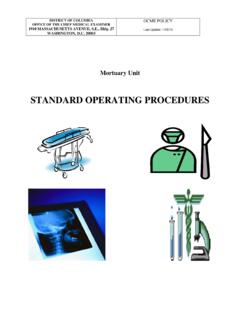Transcription of On Writing Well, 30th Anniversary Edition: An Informal ...
1 OnWritingWell30th Anniversary EditionTHE CLASSIC GUIDE TOWRITING NONFICTIONW illiam ZinsserCONTENTSCOVERTITLE PAGEINTRODUCTIONPART I Principles 1 The Transaction 2 Simplicity 3 Clutter 4 Style 5 The Audience 6 Words 7 UsagePART II Methods 8 Unity 9 The Lead and the Ending10 Bits & PiecesPART III Forms11 Nonfiction as Literature12 Writing About People: The Interview13 Writing About Places: The Travel Article14 Writing About Yourself: The Memoir15 Science and Technology16 Business Writing : Writing in Your Job17 Sports18 Writing About the Arts: Critics and Columnists19 HumorPART IV Attitudes20 The Sound of Your Voice21 Enjoyment, Fear and Confidence22 The Tyranny of the Final Product23 A Writer s Decisions24 Writing Family History and Memoir25 Write as well as You CanSOURCESINDEXABOUT THE AUTHOROTHER WORKSCOPYRIGHTABOUT THE PUBLISHERINTRODUCTIONOne of the pictures hanging in my office in mid-Manhattan is a photograph ofthe writer E.
2 B. White. It was taken by Jill Krementz when White was 77 yearsold, at his home in North Brooklin, Maine. A white-haired man is sitting on aplain wooden bench at a plain wooden table three boards nailed to four legs in a small boathouse. The window is open to a view across the water. White istyping on a manual typewriter, and the only other objects are an ashtray and anail keg. The keg, I don t have to be told, is his people from many corners of my life writers and aspiring writers,students and former students have seen that picture. They come to talkthrough a Writing problem or to catch me up on their lives. But usually it doesn ttake more than a few minutes for their eye to be drawn to the old man sitting atthe typewriter.
3 What gets their attention is the simplicity of the process. Whitehas everything he needs: a Writing implement, a piece of paper, and a receptaclefor all the sentences that didn t come out the way he wanted them then Writing has gone electronic. Computers have replaced thetypewriter, the delete key has replaced the wastebasket, and various other keysinsert, move and rearrange whole chunks of text. But nothing has replaced thewriter. He or she is still stuck with the same old job of saying something thatother people will want to read. That s the point of the photograph, and it s stillthe point 30 years later of this first wrote On Writing well in an outbuilding in Connecticut that was assmall and as crude as White s boathouse.
4 My tools were a dangling lightbulb, anUnderwood standard typewriter, a ream of yellow copy paper and a wirewastebasket. I had then been teaching my nonfiction Writing course at Yale forfive years, and I wanted to use the summer of 1975 to try to put the course intoa B. White, as it happened, was very much on my mind. I had longconsidered him my model as a writer. His was the seemingly effortless style achieved, I knew, with great effort that I wanted to emulate, and whenever Ibegan a new project I would first read some White to get his cadences into myear. But now I also had a pedagogical interest: White was the reigning champ ofthe arena I was trying to enter. The Elements of Style, his updating of the bookthat had most influenced him, written in 1919 by his English professor at Cornell,William Strunk Jr.
5 , was the dominant how-to manual for writers. of competing with the Strunk & White book I decided to complementit. The Elements of Style was a book of pointers and admonitions: do this, don tdo that. What it didn t address was how to apply those principles to the variousforms that nonfiction Writing and journalism can take. That s what I taught in mycourse, and it s what I would teach in my book: how to write about people andplaces, science and technology, history and medicine, business and education,sports and the arts and everything else under the sun that s waiting to be On Writing well was born, in 1976, and it s now in its third generation ofreaders, its sales well over a million. Today I often meet young newspaperreporters who were given the book by the editor who hired them, just as thoseeditors were first given the book by the editor who hired them.
6 I also often meetgray-haired matrons who remember being assigned the book in college and notfinding it the horrible medicine they expected. Sometimes they bring that earlyedition for me to sign, its sentences highlighted in yellow. They apologize for themess. I love the America has steadily changed in 30 years, so has the book. I ve revised itsix times to keep pace with new social trends (more interest in memoir, business,science and sports), new literary trends (more women Writing nonfiction), newdemographic patterns (more writers from other cultural traditions), newtechnologies (the computer) and new words and usages. I ve also incorporatedlessons I learned by continuing to wrestle with the craft myself, Writing books onsubjects I hadn t tried before: baseball and music and American history.
7 Mypurpose is to make myself and my experience available. If readers connect withmy book it s because they don t think they re hearing from an English re hearing from a working concerns as a teacher have also shifted. I m more interested in theintangibles that produce good Writing confidence, enjoyment, intention,integrity and I ve written new chapters on those values. Since the 1990s I vealso taught an adult course on memoir and family history at the New School. Mystudents are men and women who want to use Writing to try to understand whothey are and what heritage they were born into. Year after year their stories takeme deeply into their lives and into their yearning to leave a record of what theyhave done and thought and felt.
8 Half the people in America, it seems, are writinga bad news is that most of them are paralyzed by the size of the task. Howcan they even begin to impose a coherent shape on the past that vast sprawl ofhalf-remembered people and events and emotions? Many are near despair. Tooffer some help and comfort I wrote a book in 2004 called Writing About YourLife. It s a memoir of various events in my own life, but it s also a teaching book:along the way I explain the Writing decisions I made. They are the same decisionsthat confront every writer going in search of his or her past: matters of selection,reduction, organization and tone. Now, for this seventh edition, I ve put thelessons I learned into a new chapter called Writing Family History and Memoir.
9 When I first wrote On Writing well , the readers I had in mind were a smallsegment of the population: students, writers, editors, teachers and people whowanted to learn how to write. I had no inkling of the electronic marvels thatwould soon revolutionize the act of Writing . First came the word processor, inthe 1980s, which made the computer an everyday tool for people who had neverthought of themselves as writers. Then came the Internet and e-mail, in the1990s, which continued the revolution. Today everybody in the world is writingto everybody else, making instant contact across every border and across everytime zone. Bloggers are saturating the one level the new torrent is good news. Any invention that reduces thefear of Writing is up there with air-conditioning and the lightbulb.
10 But, as always,there s a catch. Nobody told all the new computer writers that the essence ofwriting is rewriting. Just because they re Writing fluently doesn t mean they rewriting condition was first revealed with the arrival of the word processor. Twoopposite things happened: good writers got better and bad writers got writers welcomed the gift of being able to fuss endlessly with theirsentences pruning and revising and reshaping without the drudgery ofretyping. Bad writers became even more verbose because Writing was suddenlyso easy and their sentences looked so pretty on the screen. How could suchbeautiful sentences not be perfect?E-mail is an impromptu medium, not conducive to slowing down or lookingback.






